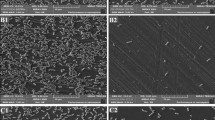Abstract
It is demonstrated that numerous bacteria are able to attach to surfaces of equipment used for food handling or processing. In this study, a strain of Enterococcus durans, originally isolated from a milking machine surface, was firstly studied for its biofilm formation potential on plastic and stainless steel supports. The strain was found to be a biofilm producer either at 25, 30 or 37 °C on polystyrene microtitre plates, with a best adherence level observed at 25 °C. En. durans showed a strong adhesion to stainless steel AISI-304. Antibacterial and anti-adherence activities of En. durans were tested against four foodborne pathogens (Escherichia coli ATCC 25922, Staphylococcus aureus ATCC 25923, Pseudomonas aeruginosa ATCC 27853 and Listeria innocua CLIP 74915) which were shown as biofilm producers on both plastic and stainless steel. En. durans cells and cell-free culture supernatant showed a significant (P < 0.05) inhibition potential of the pathogens either on solid media or in broth co-cultures. Characterization of the antibacterial substances indicated their proteinaceous nature which assigned them most probably to bacteriocins group.




Similar content being viewed by others
References
Bellon-Fontaine MN, Cerf O (1990) Experimental determination of spreading pressure in solid and liquid vapor systems. J Adh Sci Tech 4:475–480
Beresford MR, Andrew PW, Shama G (2001) Listeria monocytogenes adheres to many materials found in food-processing environments. J App Microbiol 90:1000–1005
Bower CK, McGuire J, Daeschel MA (1995) Suppression of Listeria monocytogenes colonization following adsorption of nisin onto silica surfaces. App Environ Microbiol 61:992–997
Carpentier B, Cerf O (1993) Biofilms and their consequences, with particular reference to hygiene in the food industry. J App Bacteriol 75:499–511
Chavant P, Martinie B, Meylheuc T, Bellon-Fontaine MN, Hébraud M (2002) Listeria monocytogenes LO28: surface physicochemical properties and ability to form biofilms at different temperatures and growth phases. App Environ Microbiol 68:728–737
Chmielewski RAN, Frank JF (2003) Biofilm formation and control in food processing facilities. Compr Rev Food Sci Food Saf 2:22–32
Costerton JW, Lewandowski Z, Caldwell DE, Korber DR, Lappin Scott HM (1995) Microbial biofilms. Ann Rev Microbiol 49:711–745
Giraffa G (1995) Enterococcal bacteriocins: their potential use as anti-Listeria factors in dairy technology. Food Microbiol 12:291–299
Giraffa G (2003) Functionality of enterococci in dairy products. Int J Food Microbiol 88:215–222
Hall-Stoodley L, Costerton JW, Stoodley P (2004) Bacterial biofilm: from the natural environment to infectious diseases. Nat Microbiol Rev 2:95–108
Kumar C, Anand SK (1998) Significance of microbial biofilms in food industry. Int J Food Microbiol 42:9–27
Leriche V, Carpentier B (2000) Limitation of adhesion and growth of Listeria monocytogenes on stainless steel surfaces by Staphylococcus sciuri biofilms. J App Microbiol 88:594–605
Leriche V, Chassaing D, Carpentier B (1999) Behaviour of L. monocytogenes in an artificially made biofilm of a nisin-producing strain of Lactococcus lactis. Int J Food Microbiol 51:169–182
Lewis SJ, Gilmour A, Fraser TW, McCall RD (1987) Scanning electron microscopy of soiled stainless steel inoculated with single bacterial cells. Int J Food Microbiol 4:279–284
Morikawa M (2006) Beneficial biofilm formation by industrial bacteria Bacillus subtilis and related species. J Biosci Bioeng 1:1–8
Muriana PM (1996) Bacteriocin for control of Listeria spp. in food. J Food Prot Suppl.: 54-63
Norwood DE, Gilmour A (1999) Adherence of Listeria monocytogenes strains to stainless steel coupons. J App Microbiol 86:576–582
O’Toole GA, Pratt LA, Watnick PI, Newman DK, Weaver VB, Kolter R (1999) Genetic approaches to study of biofilms. Meth Enzymol 310:91–109
Ogier JC, Serror P (2008) Safety assessment of dairy microorganisms: the Enterococcus genus. Int J Food Microbiol 126:291–301
Onda T, Yanagida F, Uchimura T, Tsuji M, Ogino S, Shinohara T, Yokotsuka K (2002) Widespread distribution of the bacteriocin-producing lactic acid cocci in miso-paste products. J App Microbiol 92:695–705
Reij MW, Den Aantrekker ED (2003) Recontamination as a source of pathogens in processed foods. ILSI Europe risk analysis in microbiology task forceb. 12-31
Stepanovic S, Vukovic D, Dakic I, Savic B, Svabic-Vlahovic M (2000) A modified microtiter-plate test for quantification of staphylococcal biofilm formation. J Microbiol Meth 40:175–179
Yanagida F, Chen Y, Onda T, Shinohara T (2005) Durancin L28-1A, a new bacteriocin from Enterococcus durans L28-1, isolated from soil. Lett App Microbiol 40:430–435
Acknowledgments
We thank Pr Frederik Cuisinier, Laboratoire de Bio-santé et Nanoscience, URF d’odontologie, Université Montpellier 1 (France), for the time spent in its laboratory and Dr Estel Bilak, Laboratoire de Bactériologie et Virologie, Faculté de pharmacie, Université Montpellier 1 (France), for her assistance.
Author information
Authors and Affiliations
Corresponding author
Rights and permissions
About this article
Cite this article
Amel, A.M., Farida, B. & Djamila, S. Anti-adherence potential of Enterococcus durans cells and its cell-free supernatant on plastic and stainless steel against foodborne pathogens. Folia Microbiol 60, 357–363 (2015). https://doi.org/10.1007/s12223-014-0367-6
Received:
Accepted:
Published:
Issue Date:
DOI: https://doi.org/10.1007/s12223-014-0367-6




